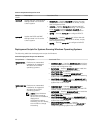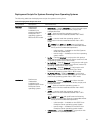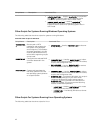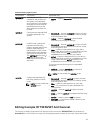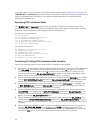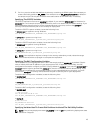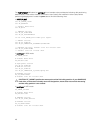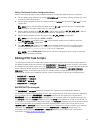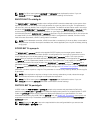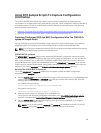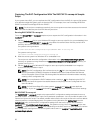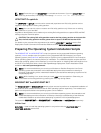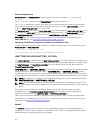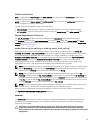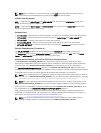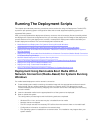
NOTE: For 9G or later systems, racrep.sh and sysrep.sh have duplicate functions. If you run
racrep.sh followed by sysrep.sh, the latter overwrites the settings of the former.
RAIDCFG.BAT Or raidcfg.sh
The RAIDCFG.BAT or raidcfg.sh sample script configures RAID controllers detected on the system. User
input is optional to run this script. The input parameter is a name or path to a log file. This parameter is
not set to any value by default, and no log file is generated. The default variable values used in this script
are set in the TKENVSET.BAT or tkenvest.sh scripts. This script uses the RAIDCFG.EXE or raidcfg.sh utility
to automatically configure the detected controllers on your target system. For example, for the first
controller discovered, if RAIDCFG.EXE or raidcfg.sh discovers only one attached hard drive, the script tries
to create RAID 0; if two hard drives are discovered, a RAID 1 configuration is enabled; if three or more
hard drives are discovered, a RAID 5 configuration is enabled.
NOTE: On the detected controller, a RAID virtual disk is created only if the array disks connected to
that particular controller have space available and, where applicable, are not part of already existing
array group.
SYSREP.BAT Or sysrep.sh
The SYSREP.BAT or sysrep.sh sample script applies SYSCFG options to the target system based on
configuration information that has been saved in a configuration file. User input is optional to run this
script, depending on the variable settings in the SYSREP.BAT orsysrep.sh scripts. This script uses the
SYSCFG utility to configure the BIOS and BMC in the target system using the configuration file syscfg.in.
Thesyscfg.in is the first parameter passed to this script. If this parameter is not passed, the default
variables values used in this script are set in the SYSREP.BAT or sysrep.sh scripts. The syscfg.ini file is
generated with the SYSCAP.BAT or syscap.sh sample script. For information about using the SYSCAP.BAT
or syscap.sh sample script to capture BIOS and BMC settings, see SYSCAP.BAT Or syscap.sh. The second
parameter is a name or path to a log file. This parameter is not set to any value by default, and no log file
is generated.
NOTE: If the replication requires a change in the memory redundancy mode, reboot the target
server and execute the script again to complete the replication.
NOTE: For 9G or later systems, racrep.sh and sysrep.sh have duplicate functions. If you run
racrep.sh followed by sysrep.sh, the latter overwrites the former settings.
PARTCFG.BAT Or partcfg.sh
In BIOS mode, the PARTCFG.BAT or partcfg.sh sample script creates and populates the Dell utility
partition using UPINIT.BAT or upinit.sh and creates the deployment partition on a specified disk. In UEFI
mode, the partcfg.sh sample script creates the deployment partition on a specified disk. For more
information about using the UPINIT.BAT or upinit.sh tool, see UPINIT.BAT Or upinit.sh. User input is not
required to run this script. The default variable values used in this script are set in the TKENVSET.BAT or
tkenvset.sh scripts.
NOTE: Ensure that DT_HD is set to the required disk to be configured before you execute the
PARTCFG.BAT or partcfg.sh script.
48



